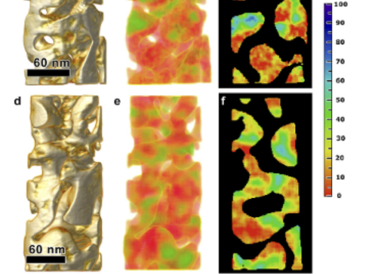Christoph Mahr, Paromita Kundu, Anastasia Lackmann, Daniele Zanaga, Karsten Thiel, Marco Schowalter, Martin Schwan, Sara Bals, Arne Wittstock, Andreas Rosenauer
Journal of Catalysis (2017) 352, 52-58
https://doi.org/10.1016/j.jcat.2017.05.002
Large efforts have been made trying to understand the origin of the high catalytic activity of dealloyed nanoporous gold as a green catalyst for the selective promotion of chemical reactions at low temperatures. Residual silver, left in the sample after dealloying of a gold-silver alloy, has been shown to have a strong influence on the activity of the catalyst. But the question of how the silver is distributed within the porous structure has not finally been answered yet. We show by quantitative energy dispersive X-ray tomography measurements that silver forms clusters that are distributed irregularly, both on the surface and inside the ligaments building up the porous structure. Furthermore, we find that the role of the residual silver is ambiguous. Whereas CO oxidation is supported by more residual silver, methanol oxidation to methyl formate is hindered. Structural characterisation reveals larger ligaments and pores for decreasing residual silver concentration.


